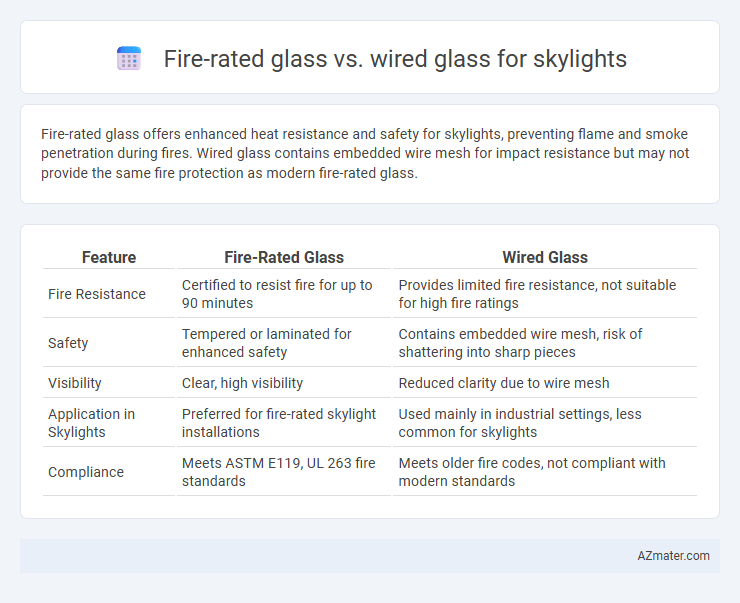Fire-rated glass offers enhanced heat resistance and safety for skylights, preventing flame and smoke penetration during fires. Wired glass contains embedded wire mesh for impact resistance but may not provide the same fire protection as modern fire-rated glass.
Table of Comparison
| Feature | Fire-Rated Glass | Wired Glass |
|---|---|---|
| Fire Resistance | Certified to resist fire for up to 90 minutes | Provides limited fire resistance, not suitable for high fire ratings |
| Safety | Tempered or laminated for enhanced safety | Contains embedded wire mesh, risk of shattering into sharp pieces |
| Visibility | Clear, high visibility | Reduced clarity due to wire mesh |
| Application in Skylights | Preferred for fire-rated skylight installations | Used mainly in industrial settings, less common for skylights |
| Compliance | Meets ASTM E119, UL 263 fire standards | Meets older fire codes, not compliant with modern standards |
Introduction to Skylight Glazing Options
Fire-rated glass and wired glass serve distinct roles in skylight glazing options, balancing safety and visibility requirements. Fire-rated glass offers superior heat resistance and fire protection while maintaining clarity and light transmission. Wired glass, embedded with a metal mesh, provides structural integrity during fire but can compromise transparency and aesthetics in skylight applications.
What is Fire-Rated Glass?
Fire-rated glass is specially designed to resist heat and flames for a specified period, maintaining the integrity of skylight assemblies during a fire emergency. It incorporates layers of tempered glass and intumescent materials that expand when exposed to high temperatures, thereby preventing the spread of fire and smoke. Unlike wired glass, fire-rated glass provides superior clarity and safety performance while complying with stringent fire protection standards in commercial and residential buildings.
What is Wired Glass?
Wired glass is a type of safety glass embedded with a metal wire mesh to enhance fire resistance and prevent shattering under heat stress, commonly used in skylight applications to provide added security and fire protection. Unlike standard fire-rated glass, wired glass maintains structural integrity during fire exposure but may compromise visibility due to its embedded mesh. Choosing wired glass for skylights ensures fire safety compliance while offering durability against impacts and high temperatures.
Fire Performance: Fire-Rated Glass vs Wired Glass
Fire-rated glass provides superior fire resistance by withstanding high temperatures and preventing the spread of flames and smoke during a fire, meeting strict fire safety codes and standards. Wired glass, embedded with a metal mesh, offers limited fire protection by maintaining its structural integrity under heat but is prone to shattering on impact, reducing overall fire performance. For skylights, fire-rated glass ensures enhanced occupant safety and code compliance by combining heat resistance with visibility and durability that wired glass cannot match.
Safety and Strength Comparison
Fire-rated glass for skylights offers superior heat resistance and maintains structural integrity during exposure to high temperatures, preventing fire spread and ensuring occupant safety. Wired glass, while providing a basic barrier with embedded wire mesh, tends to weaken under thermal stress and can shatter more easily, compromising fire containment. The enhanced safety and strength of fire-rated glass make it a preferable choice for skylights in fire-sensitive architectural applications.
Aesthetic Differences for Skylights
Fire-rated glass for skylights offers a sleek, clear appearance that maintains unobstructed natural light and modern aesthetics, making it ideal for contemporary architectural designs. Wired glass, featuring embedded wire mesh, provides a textured, industrial look that can disrupt visual clarity and cast shadows, often resulting in a more utilitarian or vintage style. Choosing between fire-rated and wired glass impacts both the visual appeal and the ambiance created by the skylight, with fire-rated glass favoring minimalism and wired glass emphasizing rugged texture.
Energy Efficiency and Insulation
Fire-rated glass for skylights offers superior insulation properties, significantly reducing heat transfer compared to wired glass, which tends to have higher thermal conductivity. Energy efficiency is enhanced in fire-rated glass due to its multi-layered construction that provides better thermal resistance and reduces HVAC loads. In contrast, wired glass, while providing basic fire resistance and safety, often lacks the advanced insulation performance required for optimal energy savings in skylights.
Cost Considerations
Fire-rated glass for skylights typically incurs higher upfront costs due to advanced materials and certification requirements, often ranging from $50 to $100 per square foot. Wired glass is more affordable, usually priced between $15 and $30 per square foot, but may lack the same fire protection ratings and energy efficiency. Long-term cost considerations should include maintenance, durability, and compliance with building codes, where fire-rated glass might offer better value despite initial expenses.
Building Code and Compliance Requirements
Fire-rated glass used in skylights meets stringent building code requirements such as ASTM E119 and NFPA 257 for fire resistance, providing up to 90 minutes of protection against fire and smoke spread. Wired glass, historically common for fire-resistance, often fails to comply with modern building codes like the International Building Code (IBC) due to its brittleness and decreased integrity after impact. Compliance mandates selecting fire-rated glass tested for fire endurance and impact resistance to ensure structural safety and code adherence in skylight installations.
Choosing the Right Glass for Your Skylight
Selecting the right glass for your skylight involves balancing safety, fire resistance, and aesthetics, with fire-rated glass offering superior heat insulation and fire containment compared to wired glass. Fire-rated glass is engineered to withstand high temperatures while maintaining clarity and structural integrity, making it ideal for areas requiring strict fire codes compliance. Wired glass, although providing basic fire resistance and strengthening through its embedded wire mesh, tends to obscure visibility and is less effective in preventing fire spread or heat transfer.

Infographic: Fire-rated glass vs Wired glass for Skylight
 azmater.com
azmater.com